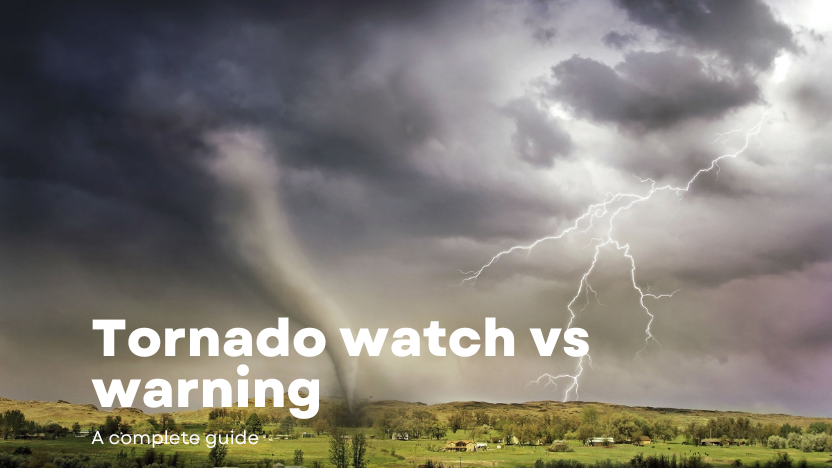Tornado watch vs warning

A tornado watch is a significant meteorological warning to take seriously. There is a warning when conditions are right for tornadoes in a local area. This does not have been a tornado, however, it is an indicator letting you know to be prepared and to stay updated in case things evolve.
In this blog, we are going to give you a few things to know about a Tornado Watch as well as an explanation of why it is significant and what you should do when one has been issued. He will have you understanding how to be safe once under a tornado watch and why being prepared is of the essence.
What Is a Tornado Watch?
A tornado watch is an alert issued by the National Weather Service (NWS) when conditions are good for the formation of tornadoes in a particular area. This combination of weather conditions includes the right ingredients for strong winds, severe thunderstorms, and the possibility of tornadoes. A tornado watch is issued for a large area and lasts several hours from the time it is announced.
Please remember that a Tornado Watch is not the same as a Tornado Warning. A watch is when a tornado may be expected, but has not yet been sighted. Consider this as a warning of adverse weather conditions.
Elements of a Tornado Watch
The tornado watch has some important elements that help people understand the danger at hand:
1. Wide Areas Covered: Typically a tornado watch covers large areas, including multiple counties or whole states depending on the atmospheric patterns. It is because tornadoes can form over a broad area and meteorologists want to alarm as many individuals as possible.
2. Duration: The process used to bring a tornado watch into effect lasts an hour, generally preventing it from lasting for less than 1 -2 hours. For example, you may hear about a tornado watch from noon to 8 pm.
3. Weather Condition: Weather conditions include heavy winds, severe thunderstorms, and unstable air streams. All of these conditions increase the potential that a tornado may develop.
4. Tornado Watch: A tornado watch is not a threat to you right now, but implies that the weather has created a potential for… Prepare and be on alert for destructive atmospheric conditions! At this point, you must begin considering what to do if the tornado warning is issued later.
Why Tornado Watch Is Important?
Tornados are just bad to the bone. They have the potential to cause widespread damage, crush houses and even kill any living being. It is for this reason that keeping track of a tornado watch all the time, round the clock, is very important. Why a tornado watch means business:
1. First Alert: A Tornado Watch signals a warning before one hits. However, it gets you ready for that potential tornado before it ever develops. You can take this time to protect your family and home.
2. Lead Time: Tornado watches are issued hours in advance of the actual tornado, giving you plenty of time to prepare. You can prepare by gathering supplies, clearing out your storm shelter, and checking the latest in your updates this way.
3. Be Alert: When under a tornado watch, means that conditions are favorable for some strong tornadoes to form. This will allow you to follow the storm as it grows and continues, and that is something far more insistent; a tornado warning.
4. Protection for Communities: Tornado watches are crucial to keeping everyone in a community safe from harm. This information is then used by schools, businesses, and emergency services to put plans in place as to how they will keep people safe.
What to do during a tornado watch
For as long as the tornado watch remains active, it is important that you are prepared and know what to do next. A list of what you must do:
1. Be Informed — Monitor weather conditions and be aware of the latest forecast. If you are caught in a storm, find shelter by staying in your car or indoors and check local news stations such as CNN, The Weather Channel, and local radio stations for up-to-date information. If the weather changes for the worse, be able to get updates—lots of weather apps will send alerts reminding you there are hazardous/ life-threatening conditions.
2. Create a Family Plan: Designate an area where you and your family can take cover when a tornado approaches. Know your safe place, like a basement or an interior room without windows. The whole family should be well acquainted with where to go in case a tornado will hit your home.
3. Collect essentials: During a tornado watch you should: make sure you stay informed and ready. Some of the basic essentials include flashlights, batteries, water, food, basic first-aid supplies and must-have documents like passports or insurance papers.
4. Get Your Shelter Ready: If you have a storm shelter or safe room, prepare it for use. Declutter and have it stocked with essentials in case you end up spending a prolonged amount of time there.
5. Keep Pets Safe: Do not ignore your pets while a tornado watch is in effect! Ensure they are indoors and can easily be transported to your safe place in case it is needed.
6. Minimize Travel: If there is a tornado watch, it is best to stay home. Bad weather can make driving even more dangerous. Avoid driving if possible.
Tornado Watch vs. Warning
There are tornado watches and there is also a tornado warning so let’s not get confused between the actual thing and what it could be. Here’s how they compare:
1. A Tornado Watch means that conditions are favorable for the development of tornadoes. Everybody realizes tornadoes will be possible, but they have not been sighted. Pay attention, as weather conditions can change quickly.
2. Tornado warning: A tornado warning means that it has been spotted or indicated by radar. If a tornado warning is announced, it is a severe alerting signal, and you may be close to the tornado, so take cover immediately. While a tornado watch is a “be prepared” warning, a tornado warning is a “take action now” signal. Tornado warnings provide immediate danger for a tornado to form, and in many cases, it is inevitable.
A tornado warning is often based on real-time data, such as storm rotation observed on a weather radar, or a funnel cloud or tornado reported by storm spotters. Therefore, the most critical action to take is to shelter fast for tornado safety. While tornadoes are unpredictable, there are a few things you can do to protect yourself and your family.
During a tornado: where to go during a tornado
1. Reach a Shelter: A reliable structure is where you need to be during a twister. Basements, storm shelters, or safe rooms on the lowest floor are excellent options.
2. Avoid windows: Beating debris will smash windows so stay away from a wall of glass in a safe space.
3. Cover Yourself: If you shelter an awareness, protect your head and neck. At least a mattress or cushions can shield you from debris.
4. Vehicle Tornado Risk: Do not remain in a car or a mobile house. Tornadoes will lift vehicles and destroy mobile residences.
5. Listen to the Authorities: In all instances, follow guidelines from officials and emergency services Official news releases will update as necessary on weather and safety information.
Conclusion
A tornado watch is an important weather alert that by definition means “keep an eye on the sky” because you may need to take cover at a moment’s notice. That did not mean a tornado was actually happening, more of a warning to be on the lookout and prepare.
Therefore, the topic is important in learning the differences between a tornado watch and a tornado warning to avoid dangers. A tornado watch merely means that the environment is right for tornado development, implying that you should be alert. A tornado warning on the other hand means a tornado has been spotted or has been picked on the radar and some action should therefore be taken to ensure that one takes cover immediately. Understanding how to react positively to both may help prevent the loss of life and reduce the actualization of injuries during natural calamities.







